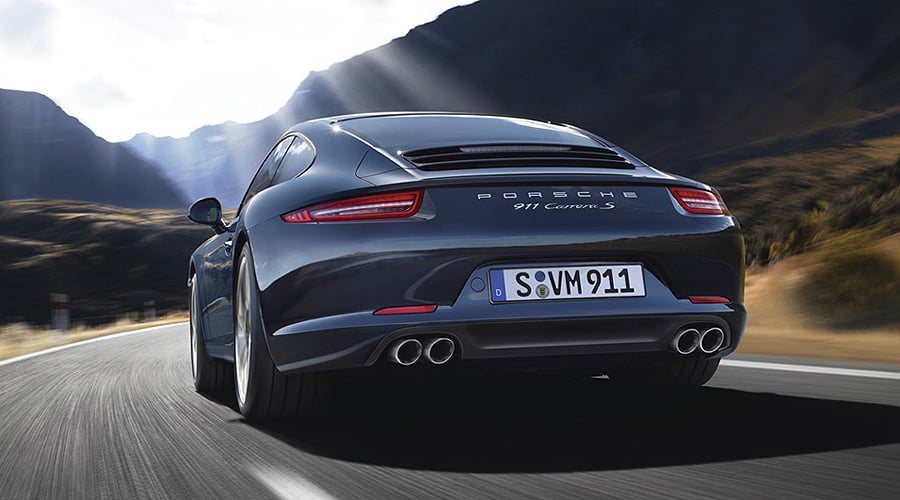
What a sound. The new Porsche 911 Carrera not only offers driving pleasure and performance, but a wonderful soundtrack as well. The sound engineers in Weissach have done a superb job – as our audition of the 911 orchestra reveals.
For four long years an engineering team led by Dr. Bernhard Pfäfflin, head of vibration technology and acoustics in Weissach, has researched, perfected and tweaked to make the new Porsche Carrera an auditory treat. Because when exacting Porsche drivers turn up the loud pedal, they expect special Porsche music – that’s part of the brand’s promise. And achieving that involves vehicle design, performance characteristics, materials selection, and manufacturing quality – all affecting the vehicle’s sound.
Porsche 911 Carrera / Starting Engine by classicdriver
Sound is especially important in sports cars since they should be giving us entertainment, as well as transport. Entertainment involves feedback from road to driver, the controls’ ergonomics, engine behaviour – and sound. Driving pleasure comes from a combination of all these factors. A throaty sound is key – the voice of the Porsche 911 we’ve loved for generations. “The concept of a six-cylinder boxer engine and its characteristic noise are in our genes,” explains Pfäfflin. “On the 911, of course, all the action’s at the back – the sounds of the engine, suction and exhaust.”
Porsche 991 Carrera S / Starting Engine by classicdriver
Getting this complex interaction right is a challenge – getting every component to make the right contribution. Dr. Pfäfflin explains: “The mechanical engine sound is characterised by high frequencies and has tonal components. These send messages such as quality, reliability and – most importantly – engine speed. The intake noise is, in contrast, quite low in frequency, and heavily influenced by the accelerator setting – as the driver puts his foot down the sounds convey what’s happening and give the driver feedback.” The same goes for exhaust sound which is also related to power delivery: “A key difference here is that the intake noise is comparatively quiet and audible mostly inside the vehicle, while exhaust noise is perceived both internally and externally.”
Porsche 991 Carrera S Sport / Starting Engine by classicdriver
Tuning the sound of the new 911 started in the early concept phase. The structure and size of manifold, pipes, catalytic converters and silencers were all simulated virtually before they were ever turned into metal. “No decisions were finalised until we’d simulated all sorts of variants on the computer, then created prototypes which were evaluated on the test bench and on the vehicle,” said Pfäfflin. A particular challenge was the big variety of sound requirements in different operating modes: idling, everyday traffic, routine travel, mountain driving, and sport mode on the track. “Our calculations, plus experience from the previous models, told us that a switchable gas flow is particularly important in handling such a wide range of conditions. Therefore, standard equipment on the 911 Carrera S includes an exhaust system with controllable valves. If required, a sports exhaust system is also available with even more ‘muscular’ sound.”
Porsche 911 Carrera / Driving Sequence by classicdriver
The whole orchestra contributes here. The quality of the air-intake sound tells us how much throttle we’re using, whereas the volume depends mainly on the power output. Mechanical engine noise increases with engine speed. In a Porsche, nothing’s contrived or faked, all the sounds are genuine. However, the engineers have developed ‘Sympos’, included as standard in the Carrera: “Sympos is a passive system which brings the sound of the boxer engine into the cabin,” says Pfäfflin. Tell us more?
“An acoustic channel monitors throttle and air filter. It contains a gas-tight membrane which amplifies vibrations and transmits them mechanically to the rear parcel shelf in the interior. A controllable valve is linked to the Sport button.” But there’s more – a switchable Helmholtz coil dampens unwanted peaks in the rev range at 5,000rpm, to give the perfect result.
Porsche 911 Carrera S Sport / Driving Sequence by classicdriver
The engineers have taken things further. Gearshifts are managed to give racing-style exhaust acoustics at the tailpipe. In Sport mode, stiffer dampers plus open exhaust valves lend a race-track feel. “The engine’s throttle response is adjusted in Sport mode to give an even more direct feel,” says Pfäfflin. “At higher speeds, we even emphasise gas extraction by a short acoustic backfire.”
Ultimately, it's like an orchestra – six soloists in perfect symphony.
Text: Mathias Paulokat
Photos: Porsche / Frank Ratering

